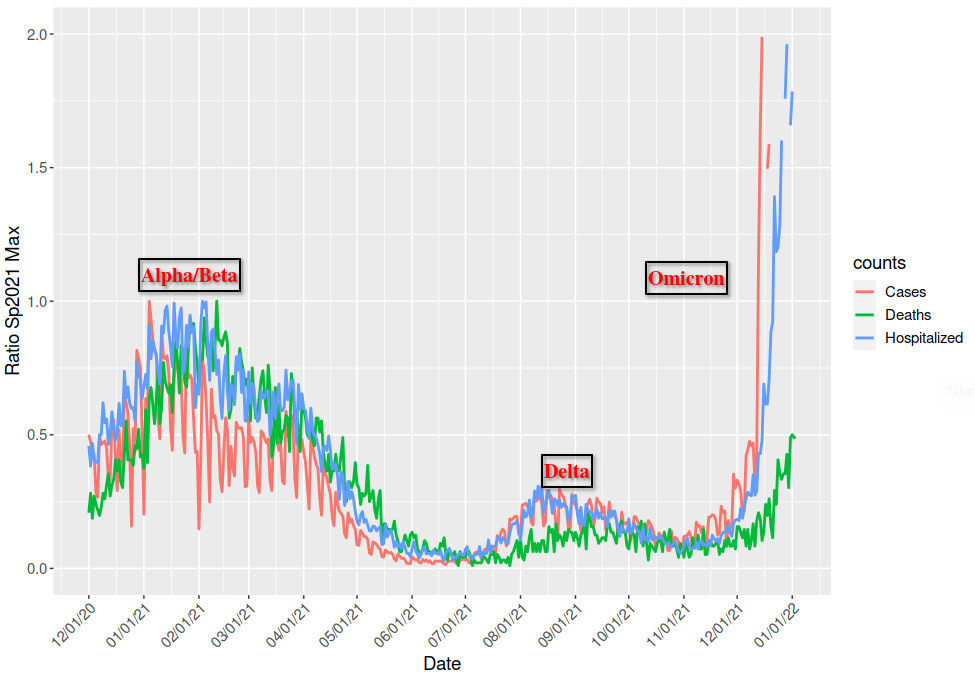There’s considerable debate about the severity of the Omicron variant with some studies showing no decreases in hospitalization rates, and others indicating otherwise. A late December Imperial College study of some 13,175 individuals with Omicron and more than 200,000 individuals with other variants indicated no difference in hospitalization rates. A much smaller study involving 132 individuals with Omicron showed 50-70% fewer hospitalizations, while another Imperial College study found a reduction in hospitalizations of 40-45%. Much of this early uncertainty comes from the fact that the “night is (was) still young” and at the time these works were published just before Christmas, there really hadn’t been time to see the results of the growing wave of Omicron.
On a parallel tract, biomedical researchers started looking at how the Omicron virus works on a cellular level. Results showed that the virus replicates in the upper airways something like 70 times more efficiently than Delta, but has a harder time infecting lung tissue. This explained its rapid spread from person to person (as the throat is closer to the mouth where the virus gets out), but also lent weight to the argument that Omicron was generally less severe. However, the deaths from Omicron have begun, so it’s clearly not that much better.
One of the key problems in analyzing true severity of Omicron is that we now have a large number of people who have been vaccinated, boosted, or who have had COVID already, and thus have some residual immunity. As such, when these individuals get Omicron, they have some protection and are likely not to experience such severe infection, although the that first death attributed to Omicron was a reinfection. But it seems that most hospitalizations where I’m writing from near Philadelphia, PA, are in the unvaccinated. Anecdotally, I know of several people who were vaccinated or boosted who have had breakthrough cases who described it like a 3-4 day cold. I also know of several vaccinated people who have had more severe cases. One even described it like a severe flu. Unpleasant.
So how does this all play out if Omicron can break through your vaccination and booster? It’s probably a bit of a coin toss. You probably won’t go to the hospital, but there’s no guarantee. You will certainly do better than the unvaccinated. But what if we just accept this as another flu and go about our business as many people seem to have been doing lately? How will this affect the availability of our healthcare?
To try to answer that question, I grabbed the data from New York City which they publish on GitHub. This is a very complete data set with large numbers and which is very localized. I wanted to see how the number of cases NOW compare to the peak from last year. I also wanted to take a look at the relative number of hospitalizations and deaths. These results are presented below.

The data are noisy as I have plotted daily data, but they do paint an interesting picture. Also, because the case count was rocketing upwards, I limited the scale so that we could see what’s happening near the x-axis, so there are a few disconnected segments towards the right hand side.
In New York City, the Delta wave which occurred this fall had about a quarter of the maximum daily cases as did the Alpha/Beta wave which peaked in January 2021. Note that the total number of cases for each peak is the area under the curve. But the Omicron wave’s peak dwarfs both prior waves for cases. It’s still going up for the time being, but is expected by some to peak later this month.
What about hospitalizations? In NYC, these data show that there are nearly twice the number of daily hospitalizations as there were a year ago and about four times as many as with Delta this fall. If we measure severity by hospitalizations, then even though the proportion of people with COVID who are hospitalized is smaller, the total number is much larger. This means that these beds are taken up and not available for others who might need hospital care. Furthermore, since nearly half a million healthcare workers have left the field since all this began, there may be fewer medical professionals to treat you if you get sick for any reason.
Finally, let’s look at the death rate. Fortunately, it’s only (yeah, right) half that of the peak last year, but it is going up. It’s possible that given the healthcare worker shortage in some areas, that the number of deaths will soon be less attributable to COVID directly, but to a broken system that is unable to respond to the demand. So again, while if you get Omicron you are less likely to die if you’ve been vaccinated and boosted, one can ask what the cost is to society when there are so many people dying.
This isn’t over yet, so please get vaccinated, get boosted, and wear your N95 masks when you’re out and about.